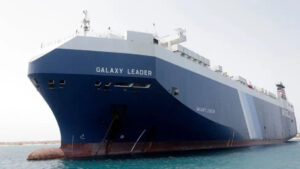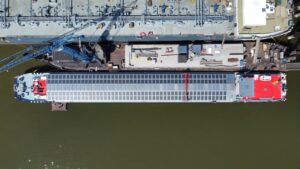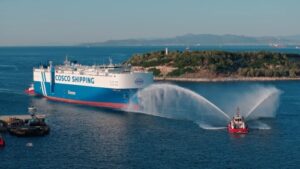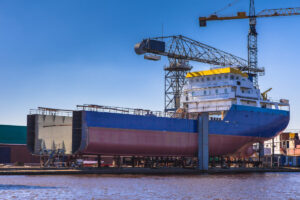Following a packed first day at SDP19, Day 2 followed up with another round of panels, keynote speeches and presentations from the world’s major ports, supply chain stakeholders and technology innovators.
As was said in the review of day one, a major talking point was data standardization and what ports can do to drive the industry and the wider supply chain towards greater collaboration. In the coming days and weeks, Port Technology will publish an array of exclusive interviews and features with some of SDP19’s leading participants, including the Port of Los Angeles, NASDAQ, INFORM, the Port of Barcelona and many, many more.
However, if you are looking for the most extensive examination of the event’s sessions and themes, make sure you get the post-event report, which you can pre-order here.
Day 2 began with a panel on the fascinating subject of Smart Port Cities and included the Ports of Los Angeles and Le Havre, as well as the Fundacion ValenciaPort, with Pascal Ollivier, President of Maritime Street moderating.
Smart cities raise many possible opportunities for innovation in data sharing and efficiency. However, they also raise many challenges, such as mobility and ensuring the safe passage of cargo through ports.
The panel looked at a number of key case studies, analysing it alongside statistics from major global bodies, such as the World Economic Forum (WEF) on the effects of cybersecurity on the wider economy.
When they are done correctly, as the panel alluded to, smart cities can have a monumentally positive effect on cargo traffic and on a city’s carbon footprint.
The first keynote speech of the day came from EagleRail’s CEO Mike Wychocki, who explored ‘Alternatives to Drayage’, the cause of so much congestion in some of the world’s biggest hubs.
Wychocki’s speech sought to answer a number of questions that many on the landside are asking, namely, how ports can continue to handle demand while vessels get bigger and shipping lanes become busier. What are the new technological solutions that are going to get rid of the bottleneck?
To that end, he was joined on stage by Yang Haisheng from Chinese port manufacturing giants ZPMC, and then by Jan Egbertsen, Port of Amsterda,, Ivano di Santo, Trieste Port Authority and Karno Tenovuo, Awake.ai in a panel discussion on ‘Intelligent Transport Solutions and Technologies.
Blockchain, the digital ledger that has been mooted as a potentially revolutionary technology for its ability to seamlessly transfer data across the supply chain, was the subject of the next panel.
It saw previous contributors to the Port Technology journal Alijosja Beije, Blocklab, and Oscar van Veen, Digital Business Solutions, Port of Rotterdam, join Johan Toll, Nasdaq, Lars Breedveld, Samsung Cello and Rutger Kalkman, ABN-AMRO, to look at what ports and terminals can learn from other sectors in utilizing blockchain’s potential.
The conversation around blockchain is, the panel pointed out, closely aligned to standards, and that the maritime industry will only achieve true efficiency and transparency once it has agreed on how to share its data.
On the point of what maritime can learn from other sectors, a striking example was banking, where major banks agreed trading standards 20 years ago, and that allowed greater transparency and transfer of information.
Colaboration between big parties on data was once again on the agenda after lunch and saw Richard Hepworth, Trelleborg, Bastian Gehnke, Navis, speak about how data can be shared between stakeholders.
What was particularly interesting from Hepworth’s presentation was the journey of a traditional manufacturing company into one developing smart solutions to increase efficiency and share data, especially how the data points can help company’s meet customer demands.
Lars Jensen, CEO, SeaIntelligence Consulting, then gave a fascinating keynote speech on the changing business environment for ports and how they can address the shifiting economic landscape. Jensen’s presentation looked at how shippers and cargo owners are shifting business expectations and urged ports to be more proactive.
He also moderated the final day, which came after a roadmap of the Port of Rotterdam’s digital twin transformation, on reducing emissions and how ports can meet the legislation put to them by the IMO and customer expectations.
As was said in the review of Day 1 an extensive review of SDP19 will be published in due course and to ensure you get a full analysis of the key sessions.








